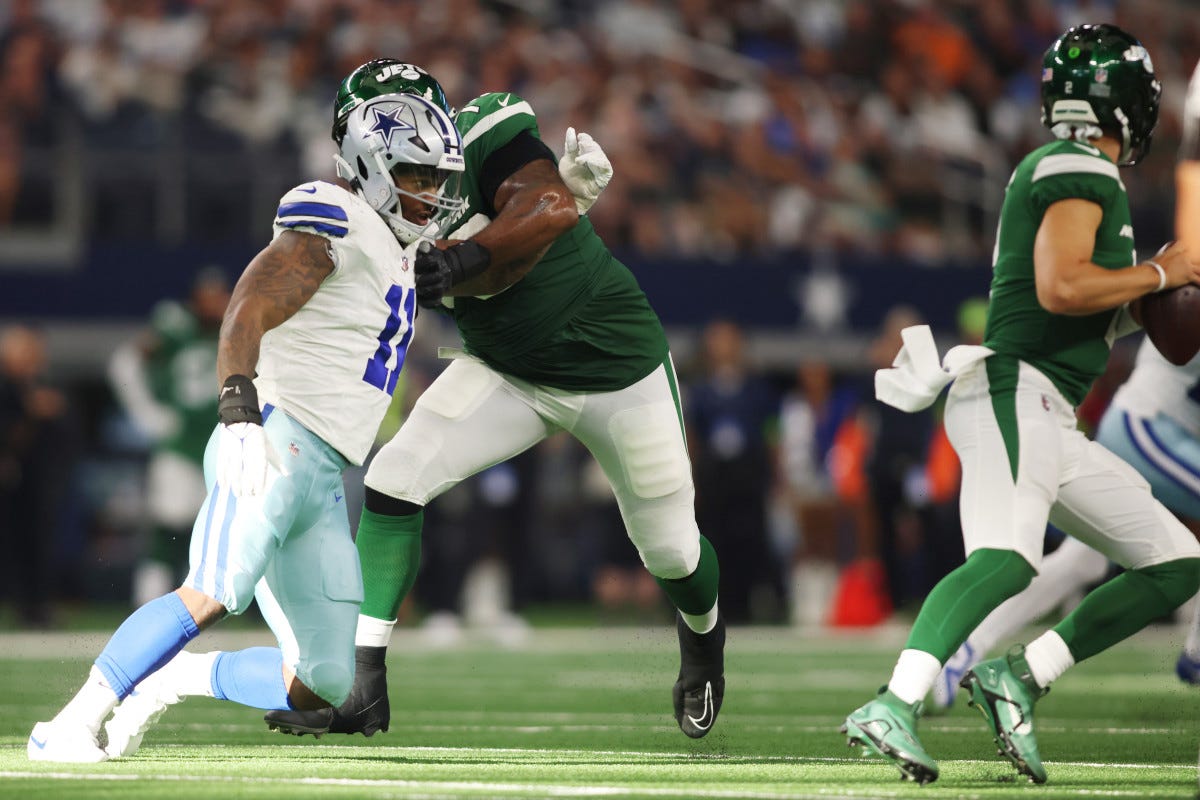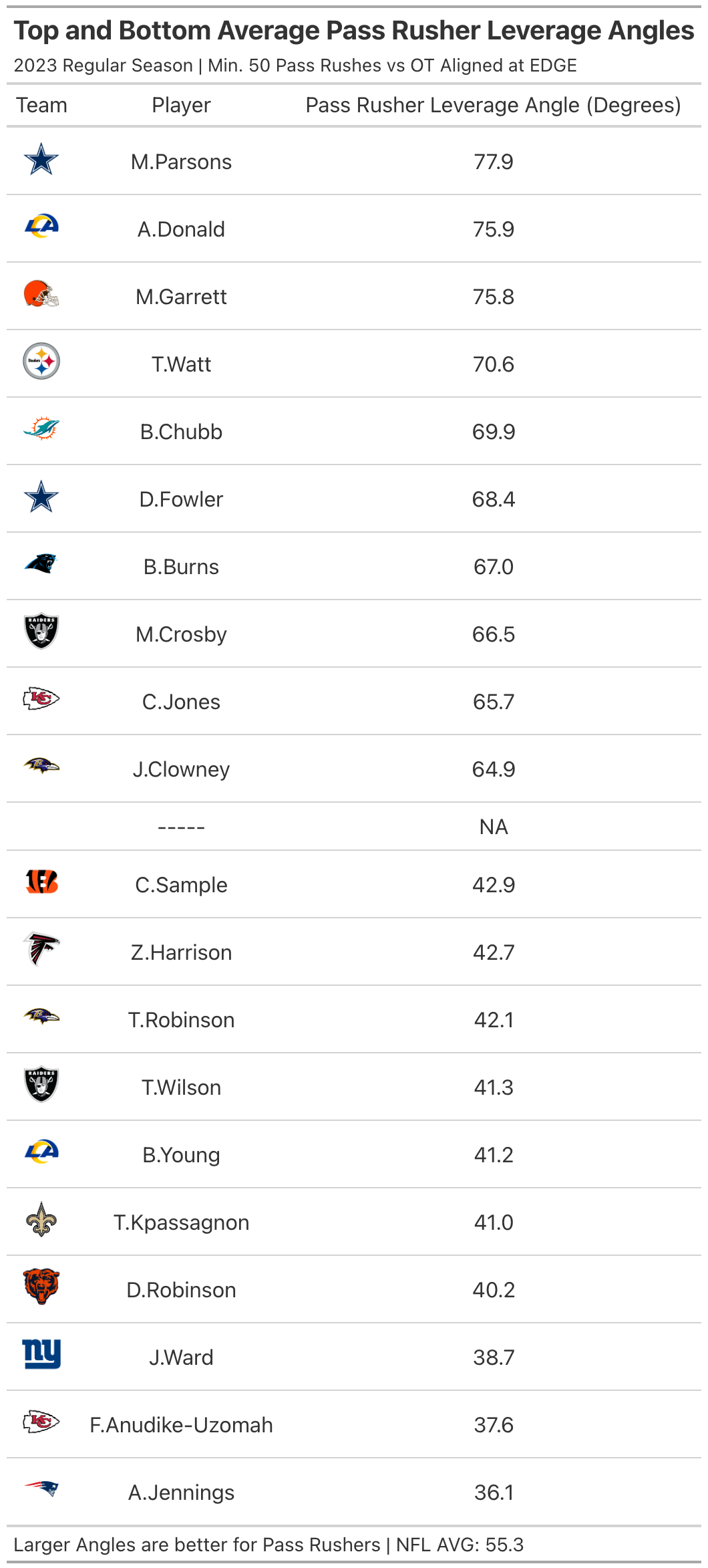Pass Rusher & Blocker Leverage Angle
A new way to measure the quality of positioning between pass rushers and pass blockers relative to the quarterback
The following project was inspired by the 2020 Big Data Bowl finalist project by Rumsey and DeFlon and Steven Patton’s leverage feature in his 2023 Big Data Bowl project.
In recent years we’ve learned that pressures predict sacks better than sacks themselves. But what predicts pressures? Like sacks, pressures are a production metric. It summarizes what happened, but it still does not tell evaluators how it happened.
The idea of tracking data is to eventually move toward trait based metrics to learn the why and how a pressure or sack happened on a play and be able to better predict which players are most likely to achieve those outcomes in the future. And with that I present Leverage Angle.
Leverage Angle is a metric that measures the quality of positioning of the pass rusher relative to his matchup (the pass blocker) and the quarterback. It is a fairly simple metric to compute — well, simple once you relearn all the trigonometry you forgot from HS.
Leverage Angle is computed by measuring the angle between the vector going from the Pass Rusher to the Pass Blocker and the vector going from the Pass Rusher to the QB. The max leverage angle is then taken on plays where a QB has at least 2.0 seconds to throw, the matchup distance is within 1.5 yards, and the time to throw on the play has not yet exceeded 2.5 seconds. (Ex. A play can last 4.5 seconds, but only the max leverage angle within 0-2.5 seconds will be accounted for.)
Pass Rusher Leverage Angle measures the quality of position a pass rusher has to make a pressure or sack; where larger the angle the better.
Pass Blocker Leverage Angle measures the quality of a pass blocker’s position; where smaller the angle the better.
Below is a diagram showing what a low and high leverage angle look like.
Play Example - NYJ at DAL Week 2, 2023
Micah Parsons led the sample of players in Pass Rusher Leverage Angle in 2022 and 2023. Here is an example of a play in which Parsons gains an extreme amount of leverage against the Jets LT Duane Brown in Week 2, 2023.
At the snap Parsons has a low leverage angle of 1.6° — which is to be expected. This angle gets slightly lower as he works into his pass rush — as low as 0.2° — before he begins to win leverage as a result of his speed and ability to flatten toward the QB at the top of his rush (moving 334°; 360° would be completely flat) around the LT.
Year-Over-Year Stability - EDGE Rushers
I filtered for EDGE rushers only as the matchup data and double teams create a difficult problem for accurately obtaining the angles for interior defensive linemen.
Leverage Angle for EDGE Rushers appears to be more stable than Leverage Angle for Pass Blockers.
This could be because Pass Rusher Leverage Angle is more about how the individual defender gains leverage en route to the QB against a pass blocker. Where Pass Blocker Leverage Angle depends on the QB drop depth and movements in the pocket — making this measure not 100% on the Pass Blocker.
How Leverage Angle Relates to Pressure
The correlation coefficient between leverage angle and pressure is 0.34, suggesting a moderate positive correlation between these two variables.
There are a lot of outlier Leverage Angle results associated with non-pressures. I went through and validated plays and the angles are correct, but there wasn’t pressure due to factors like time to throw being exactly 2 seconds, the rusher created leverage but was pushed onto the floor, the QB rolled out and avoided the pressure, etc. All legitimate reasons for a pressure not occurring despite gaining high leverage angles.
Overall, a higher pass rusher leverage angle means you’re beating the man across from you and that tends to correlate to pressure. To compare to another trait based metric — Leverage Angle’s more correlated to pressures than a pass rusher’s max speed within 2.5 seconds (r = 0.17).
I believe Pass Rusher Leverage Angle measures different skills:
1. A pass rusher’s ability to bend/flatten to the QB
2. His technical rush skills












